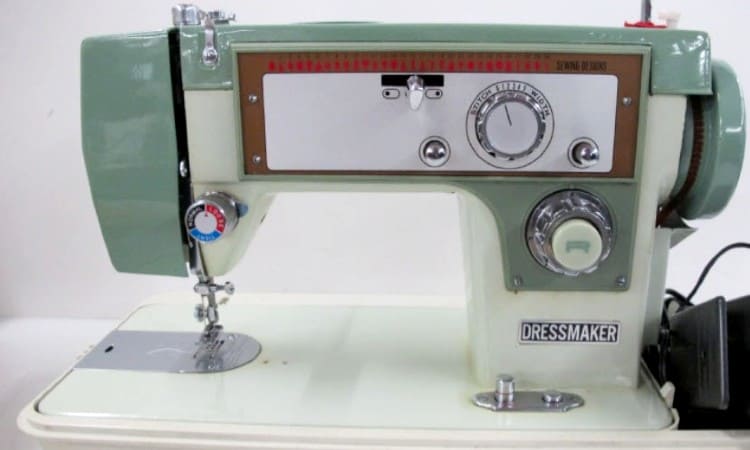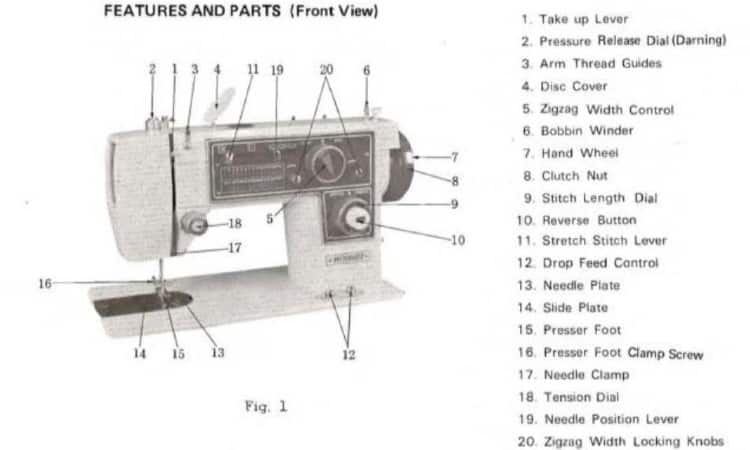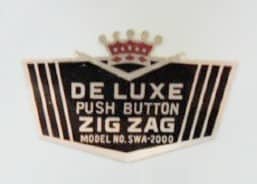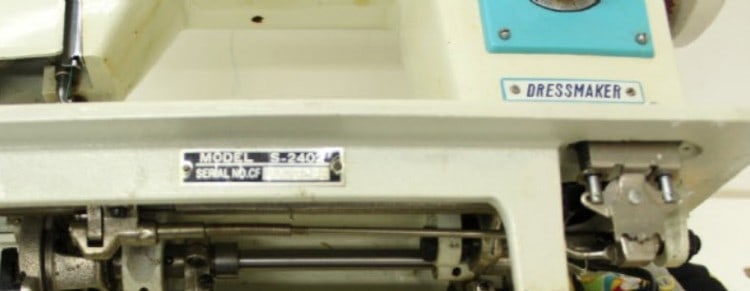Where did Dressmaker sewing machines come from, and who made them? These machines popped up out of nowhere in the mid 20th century! If you have one of these mysterious models, you probably want to know all about Dressmaker sewing machine models, history, and value.
The first Dressmaker sewing machine was the Singer 201, dubbed “the Dressmaker” for its precision sewing. Japanese companies then applied a Dressmaker logo to mass-produced Singer clones after WWII. Today, vintage Dressmaker sewing machines remain popular for their reliability.
In this article, you will find out where Dressmaker sewing machines came from. You will also discover the key characteristics of vintage Dressmaker models. Finally, you will learn how to thread and care for a vintage Dressmaker sewing machine!

Dressmaker Sewing Machine History
The first appearance of a Dressmaker sewing machine on record is the release of Singer’s famous 201 models. When it hit the market in 1935, Singer termed it “the Dressmaker.” This model offered the absolute pinnacle of functionality for sewing machines at the time!
Singer produced many notable sewing machines over the years. But the company, and many modern sewers, agree that the 201 is the best of all Singer’s vintage models. It held such popularity that Singer continued to sell it, with some minor variations, until 1961.
The 201 remains a highly sought-after collector’s item today. Unlike most old sewing machines, it often sells for high amounts, even as much as a thousand dollars!
Singer’s 201 “Dressmaker” used the name for the first time on record. It is unlikely that Singer made or sold any of the later sewing machine models that carried a Dressmaker logo.
Who Makes Dressmaker Sewing Machines?
No one knows for sure what company manufactured or sold most vintage Dressmaker sewing machines. What you can find out pretty easily is that Japanese manufacturers made most of these vintage sewing machines after the end of WWII.
For example, you can find Dressmaker models marked with clues like “Made in Japan” serial numbers. Some models also bear engraved stamps that brand the manufacturer’s name into the metal of the machine.
For example, some Dressmaker models have a “Brother” stamp engraved on the underside of the machine. You can be pretty that the Japanese company Brother made that particular model, at least!
You can also analyze the structure and features of the Dressmaker models. This lets you draw some general conclusions about the origins of the vintage models.
Most of these models look similar to what sewing machine experts call the “Model 15” or the “Class 15” clones. These “cloned” sewing machines replicated one of Singer’s sewing machines with a few minor variations here and there. Many up-and-coming Japanese manufacturers mass-produced this particular knock-off model.
After the end of the war, many Japanese war industries turned to more domestic pursuits. The United States government encouraged the sewing machine industry in Japan. The government even controversially handed over the design of one of the Singer sewing machines.
Singer, understandably, objected to this! Despite that, many of the late 1940s and early 1950s Japanese models bear a striking resemblance to the Singer model.
Knock-offs or not, many of these Japanese sewing machines feature remarkable craftsmanship! They contain solid metal parts and use careful engineering. This keeps everything inside running smoothly and creates precise, fast stitching.
You will often find that the Japanese cloned machines tend to have square, boxy cases in bright metallic colors, too!
Lots of vintage Dressmaker models on the market today have the basic blueprint of the copied Singer model. They often include advances in technology such as an automatic reverse, though. Chances are pretty good that vintage Dressmaker models were among these mid-century Singer clones.
Here comes the real mystery, though. During this era, sewing machines sold like hotcakes. This drove many large companies to purchase thousands upon thousands of Japanese-made machines.
The American company would then apply a company brand to the sewing machines before selling them in the States.
This is what happened with the Kenmore machines sold by Sears Roebuck. This process, known as “badging” sewing machines, happened regularly during the Post-WWII era.
However, no company has stepped up to claim the Dressmaker brand! To date, no records indicate that an American company bought the Japanese machines for resale. Plus, no company called “Dressmaker” existed, either!
It’s possible that Japanese manufacturers may have applied the “Dressmaker” logo themselves as a description rather than a company brand. After all, what does a sewing machine do? It sews dresses!
Whatever the origin of the Dressmaker logo, it worked! Based on the prevalence of these vintage models today, you have to assume that a good number of them sold back in the day.
Today a company called EuroPro sells a small selection of modern, mini sewing machines under the brand name Dressmaker. EuroPro seems to have launched this line around 2014 and did not sell Dressmaker sewing machines before that date.
Vintage Dressmaker Sewing Machine Models

The design features of vintage Dressmaker models indicate that most of these models sold between 1945 and 1960.
As you now know, quite a few of these models look a lot like a popular Singer sewing machine. Over time the Dressmaker models developed more advanced features on their own, though. This allowed them to keep up with changes in the sewing machine industry.
Please note that this section does not provide a comprehensive list of all vintage Dressmaker models. That said, it will give you an idea of the type of machines that you may come across bearing the Dressmaker logo.
Dressmaker 300Z
The Dressmaker 300Z features a free arm for setting sleeves and a handy extension table to provide more room for quilting or flat sewing. It also has an automatic zigzag option. Though this model does look quite similar to the Singer clones, it has a couple of key differences, such as thread tension discs mounted on the top front.
You may find threading this Dressmaker a bit daunting, as the process involves crossing the bobbin and needle threads uniquely!
No clear records exist indicating which Japanese company manufactured this Dressmaker model. But it does have more advanced technology that indicates a later manufacturing date.
Deluxe Zig Zag SWA-2000
 This solid, boxy sewing machine looks like it stepped right out of WWII! It even comes in a dull Prussian blue color scheme.
This solid, boxy sewing machine looks like it stepped right out of WWII! It even comes in a dull Prussian blue color scheme.
The bottom of the machine bears a stamp that reads “Made in Japan.” On some models, a sticker on the motor states that a company named Matsushita manufactured the machine.
Matsushita manufactured quite a lot of the Singer Class 15 clones back in the day. Today, Matsushita Industrial still exists. The company has shifted focus more towards selling industrial sewing machines, though.
The special feature of this particular model is that it has a square black push-button for changing stitching settings. This suggests that this model had a later manufacture date than some Dressmakers models. You can deduce this because earlier sewing machines required special cams to change the stitching pattern.
The Deluxe Zig-Zag model still features the outside motor and belt common to sewing machines before the 1960s.
Earlier models of the Deluxe Zig Zag may have also come in a super-cute avocado green!
S-2402
The Dressmaker S-2402 comes in a creamy metal case. Later versions seem to have a plastic case. This suggests they may have originated at the end of the vintage Dressmaker era, perhaps in the late 1960s or early 1970s.
You will want to consider this model carefully and find out if it contains any plastic parts. Internal plastic parts make a sewing machine much less durable.
That said, the S-2402 does offer 30 decorative stitching options! You do need to insert special cams to use the special stitching patterns, though. Many vintage sewing machines use these little discs that reroute the needle bar into decorative patterns.
Modern machines use computers or automatic mechanisms to make this happen, so make sure you know how to operate the cams if you want to use all those cool stitches!
The 2404 model does have an automatic zigzag stitch and three different placements as well. It has a slightly complex thread path that involves opening the front of the machine over the needle bar. This whole part of the casing swings out on a hinge!
Dressmaker 7000
The Dressmaker 7000 looks indistinguishable from the S-2402, except that it bears a tag reading “Made in Taiwan.” It has the same threading mechanism and even offers the same 30 stitching patterns!
Most likely, the prevalence of the Dressmaker logo occurred because the brand did not belong to any particular company. This allowed manufacturers in Japan and Taiwan to apply the logo liberally to their own models!
Modern Dressmaker Sewing Machine
In 2014, a sewing machine company called EuroPro launched a line of mini sewing machines branded as Dressmaker models. These modern Dressmaker models include the 998B and the Dressmaker 1100.
EuroPro does sell full-size sewing machines, such as the EuroPro X. Despite that, EuroPro does not seem to have a website of its own to promote and sell its machines. This makes tracking down info on their Dressmaker models a little tricky!
Dressmaker 998B
 The 998B runs on four AA batteries and has a small, portable case for easy transport. This little guy measures a mere 8 inches in height!
The 998B runs on four AA batteries and has a small, portable case for easy transport. This little guy measures a mere 8 inches in height!
This model provides in-a-pinch sewing, not series quilting or garment sewing functionality.
You can’t find this model for sale new anymore, but it does pop up on eBay regularly. It sells for around $40-$50.
Dressmaker 1100
The descendant of the 998B, this newer mini sewing machine has cute blue dials and detailing and claims to sew more smoothly. Unfortunately, like many portable sewing machines, the Dressmaker 1100 still has trouble with jamming threads and limited functionality.
The bottom line is that the Dressmaker 1100 looks adorable but doesn’t work super well. You can purchase it for as little as $20 today!
Dressmaker Sewing Machine Serial Numbers

Finding the serial number on a vintage sewing machine can help you track down replacement parts or sewing machine manuals. You can usually locate the serial number on a metallic sticker attached to the motor or beneath the handwheel on your vintage machine.
Unfortunately, at this time, no one has compiled an online database of Dressmaker serial numbers. This means that you won’t find it easy to match your model to a particular manufacturer by using the serial number. You also will not find a nice list telling you what year your machine was made.
You can try dating your machine in a couple of other ways, though. First, you can flip through your owner’s manual and see if it includes a date. Sometimes the manual will give you some helpful dates.
Second, you can analyze the functionality and design of the machine and determine where it falls in the timeline of sewing machine technology. This gives you at least a rough idea of what decade it came from!
For example, if you find plastic parts and gears inside, your model comes from the end of the vintage era. Likewise, if it features solid metal but only straight stitch, it probably comes from early in the vintage era, maybe the 1930s or 1940s.
Finally, please note that the serial number and model number are not the same! For example, a Dressmaker S-2402 that sold recently had a serial number of 0095204. The serial number offers a unique identification. The model number describes a whole line of sewing machines.
What is a Dressmaker Sewing Machine Worth?
Vintage Dressmaker sewing machines sell for anywhere from $20 to $200 today, but they often fall at the low end of that price range. The uncertain provenance of these old sewing machines makes them unlikely collector’s items.
That said, modern sewers often love the Dressmaker models for actual sewing! As with most vintage sewing machines, the value lies in their functionality, not their price tag.
Even though some of these vintage sewing machines have run for 50 to 70 years, they still sew just as smoothly today with proper care. This is the beauty of the solid metal parts in old sewing machines.
One easy way to test whether or not an old sewing machine is worth your effort is to pick it up. If it weighs a lot, go for it! That heavy machine probably contains solid metal parts.
If you want the assurance of getting a quality, usable vintage sewing machine, you may want to consider purchasing a refurbished Dressmaker from a technician who specializes in vintage machines. You will have to expect to pay more for a revamped vintage Dressmaker, though!
Unfortunately, the modern EuroPro mini sewing machines don’t live up to this standard. They use cheap plastic construction and don’t seem to offer careful engineering, either.
How to Thread a Dressmaker Sewing Machine for Beginners?
You can learn how to thread a Dressmaker sewing machine by following the basic steps described in this section. Your sewing machine manual will often provide illustrations showing how to thread your machine as well.
Keep in mind that vintage Dressmaker sewing machines may have a threading mechanism that looks different from modern machines.
Also, the Dressmaker models have different manufacturers. This means that not every model uses the same threading mechanism!
These guidelines will get you started, but you should refer to your sewing machine manual for specific instructions.
- Wind the bobbin and insert it into the bobbin case. Then slot the case into the shuttle. This looks just like most modern front-loading bobbins, so you will find this step easy!
- Raise the needle to its highest position using the handwheel.
- You will find double spool pins located on the top back of the machine. Place a spool of the thread on the machine with the thread on the outer side of the spool, unwinding toward the front of the machine.
- Next, slot the upper thread through the thread path. Some models come with a picture of this path printed on the case of the machine. For most, you will need to refer to the manual for specific instruction.
- For the Dressmaker 2402, use the hinged opening on the front of the machine to access a portion of the thread path. Opening this portion of the case will show you the inner lightbulb and the top of the needle mechanism.
- The first stop in the thread path is a hook located on the top front of the machine.
- Drop the thread down to wrap around the knob on the front of the machine. On many dressmaker models, the tension mechanism is located on the front of the machine, so this portion really matters!
- Inside the machine, you will see several hooks and levers. The thread should come up from the knob to catch on top of the lever a little up and to its left.
- You will find the next hook a little lower, near the needle bar.
- Drop the thread lower still to slide into the hook beside the needle bar, just over the needle.
- Thread the needle from left to right.
- Use the handwheel to raise and lower the needle, ensuring the upper thread pulls up the bobbin thread.
Dressmaker Sewing Machine Manual Free
The best way to score a free Dressmaker sewing machine manual is to ask for help on an online sewing forum. Sewers love to help each other out with information about vintage machines!
The chances are that another sewer on the discussion board owns the same Dressmaker model as you do. That sewer will almost certainly happily share the manual with you.
Unfortunately, there is no Dressmaker company. This means that you can’t reach out to the manufacturer to ask for a sewing machine manual, parts, or customer support.
If you don’t mind paying for the manual, you can purchase vintage sewing manuals on sites like this one or eBay or Amazon.
Why does the manual matter? Well, just like any appliance, you may need some help learning how to get it up and going! This matters even more for old sewing machines, though. Older machines have some quirks and unexpected features you may not know to look out for without an instruction booklet.
On top of that, sewing machine manuals teach you how to safely clean and maintain your machine!
Using the Dressmaker Sewing Machine
You will find Dressmaker models easy to use because they offer a limited range of functions. Unlike modern machines, most vintage models do a few tasks really well. They don’t feature hundreds or thousands of different functions.
You will need to learn how to wind the bobbin and thread the machine correctly. On some models, you might need to practice inserting cams for decorative stitches. After that, you’re good to go!
What can you use a Dressmaker sewing machine for? Well, these machines excel at fast, precise, basic sewing. Even the early models offer clean and speedy straight stitching that will give you what you need for basic quilting or sewing clothes.
Most Dressmaker models also feature automatic zigzag stitching. Some models come with cams that allow fancy stitching, too!
One of the big benefits of using these solid metal machines is that you can stitch through multiple layers of thick material. Double layers of denim material will not slow down these sturdy stitchers in the slightest.
If you want to sew your own jeans, go right ahead! Today you have to purchase special heavy-duty modern machines to handle denim or canvas. But these vintage machines can handle any fabric you throw at them!
Plus, you can instantly see the craftsmanship inside these machines. Just look at the neat, regular stitches they produce. So long as you have everything cleaned up, oiled, and in good order, you won’t have jamming or snagging threads, either!
Dressmaker Sewing Machine Parts
You can easily find replacement parts for Dressmaker sewing machines online. Fortunately, lots and lots of Dressmaker models flooded the market in the middle of the 20th century. That makes finding parts easier today!
Etsy, eBay, and Amazon generally offer a pretty wide range of Dressmaker parts. You can also check out online sellers who specialize in sewing machine parts, such as this store.
That said, you may have a harder time tracking down some of the special features of these vintage models. Getting the specific cams you want for the decorative stitches often proves challenging. You may have to go on a treasure hunt for these, even visiting thrift stores and antique shops till you find them!
Dressmaker Sewing Machine Price
Some Dressmaker models in good condition sell for upwards of $200, but you will most often find these models selling for very low prices like $20. These vintage machines remain popular because of their great usability, but they do not have a strong collector’s market.
You can often find them for sale in thrift stores or yard sales, too. You should probably pass up anyone asking for a lot of money for a Dressmaker model!
You can find Dressmakers quite cheaply all over the place. Don’t get roped into a scam if someone on eBay tries to claim that a vintage Dressmaker is highly collectible or antique.
Of course, that doesn’t mean that Dressmaker sewing machines don’t have value! They just aren’t considered collectible, at least not yet.
Are Dressmaker Sewing Machines Good?
Dressmaker sewing machines have a reputation for reliable, precise stitching. Most of these mid-century models have heavy metal cases and solid metal parts. This makes them super durable and tough!
It’s true that not every Dressmaker model has the same classy internal engineering that ensures great stitching. This is because so many different manufacturers made the Dressmakers. But most of the time, with proper care, these guys will run for decades, or even centuries!
Do you need a heavy-duty machine to sew through all types of fabric without any fussy computerized bells and whistles? If so, the Dressmaker may be the right sewing machine for you!
Conclusion
The mystery surrounding vintage Dressmaker sewing machines makes them quite interesting! Plus, these mid-century models typically offer reliable, precise sewing. Solid metal construction and careful engineering make them a great investment even today.
Though few records exist today, you can find clues on Dressmaker models indicating that most of them were made in Japan. It seems likely that they formed part of the Singer Clone craze that flooded the market during this era. Modern sewers often find the Dressmaker models offer even better sewing than the original Singer, though!
Do you own a vintage Dressmaker model? Can you find any clues about its origins on the machine? Leave a comment below to let us know!